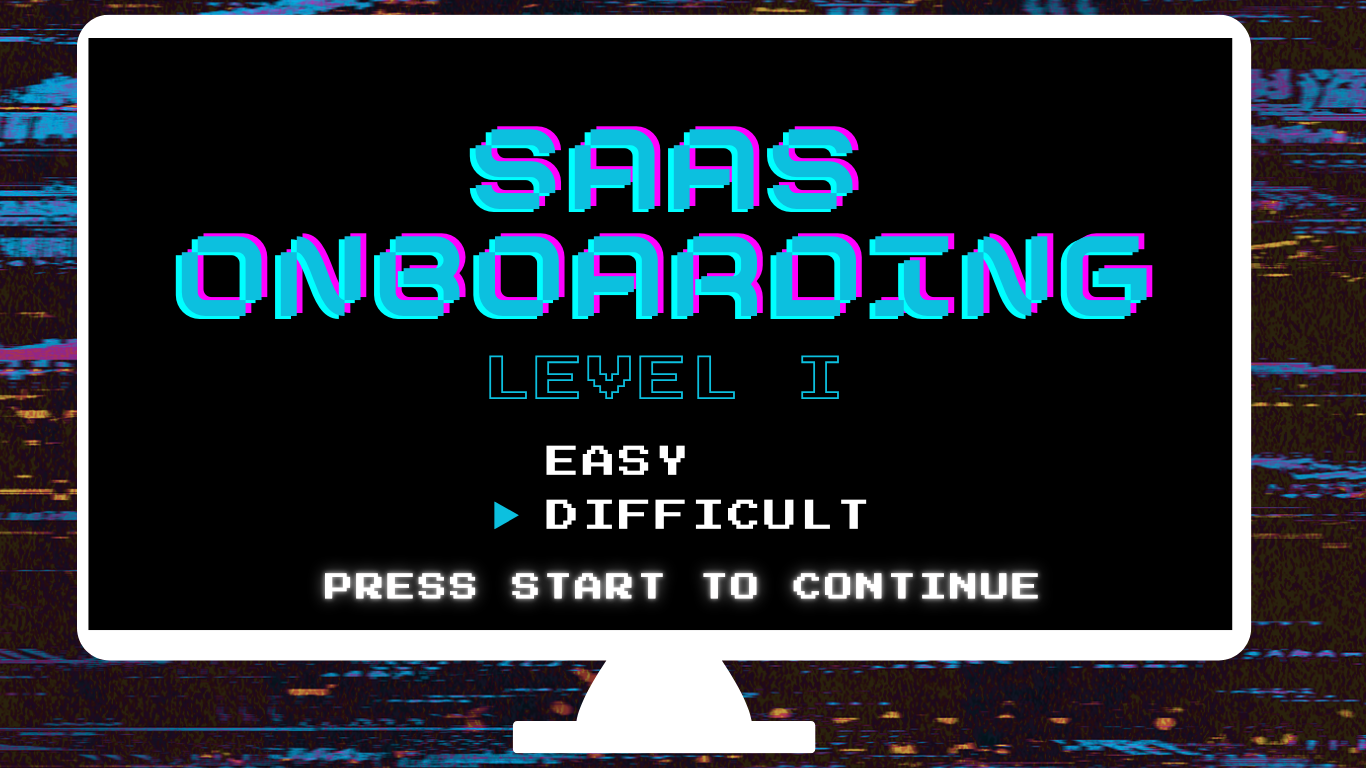Play to Learn: Gamifying SaaS Onboarding
Imagine if navigating the onboarding process of a new SaaS platform was as captivating as embarking on a journey in a beloved video game. In the realm of video games, learning the ropes is part of the thrill. Each new skill is a key unlocking the next chapter of an epic saga. Titles like "The Legend of Zelda: Breath of the Wild" and "Portal" exemplify this, marrying instruction with intrigue, guiding players through intuitive learning experiences that feel more like discovery than education. This approach not only diminishes the intimidation factor of new complexities but also transforms the novice into a proficient player almost without them noticing.
This concept presents a vibrant blueprint for SaaS companies seeking to enhance their customer onboarding experience. By drawing inspiration from how video games engage and educate, there's a promising horizon for SaaS onboarding to evolve from a mere introductory phase to an engaging, memorable journey. It's about creating an experience that users not only learn from but look forward to, setting the stage for a deeper connection with the product from the outset.
The Art of Video Game Onboarding
The secret sauce behind the addictive nature of video games isn't just in their stories or graphics—it's in how they welcome new players into their worlds. This art of onboarding is where games shine, crafting experiences that teach without overt instruction, embedding lessons in gameplay that feels as natural as breathing. Through this lens, every challenge and obstacle becomes a carefully designed lesson in disguise, ensuring that the player learns by doing, a method as old as time but as innovative as the latest tech.
Learning through Play
Consider the elegance of "The Legend of Zelda: Breath of the Wild" From the moment you step into its vast, open world, the game nudges you to experiment, explore, and expand your understanding of its mechanics organically. There's no manual, no tedious tutorial—just the game and its environment guiding you. It's a masterclass in contextual learning, where knowledge is acquired through experience and curiosity rather than rote memorization.
The Legend of Zelda: Breath of the Wild introduces a whole new level of open-world discovery that players learn through exploring instead of tutorials.
Source: The Guardian
Portal uses physics as central to its game play with increasing difficulty, but with a smooth learning curve that allows players to learn new skills/strategies that build upon each other.
Source: VICE
Similarly, "Portal" introduces its mind-bending mechanics in a way that feels like discovery. Each level builds on the last, introducing new concepts and challenges at a pace that keeps players engaged without overwhelming them. This progression ensures that by the game's end, players have mastered complex puzzles through a series of intuitive, incremental steps.
The Principles of Effective Video Game Onboarding
The brilliance of video game onboarding can be distilled into a few key principles:
Gradual Complexity: Start simple and gradually introduce complexity. This method ensures players are not overwhelmed but are continuously challenged.
Immediate Application: Allow players to immediately apply what they've learned. This practice reinforces learning and ties knowledge to action, embedding it more deeply.
Integration into Core Experience: Learning is most effective when it's part of the journey, not a detour. Video games weave tutorials into the gameplay, making education an integral part of the adventure.
These principles highlight a fundamental truth: the most effective learning experiences are those that are engaging, interactive, and seamlessly integrated into the activity itself. It’s a lesson in the psychology of learning, demonstrating that when people are having fun, they’re more open to acquiring new skills and information.
Common Pitfalls in SaaS Onboarding
While video games often turn the process of learning new systems into an engaging adventure, SaaS platforms sometimes struggle to replicate this seamless integration of education and experience. The onboarding journey for new users of SaaS products frequently encounters roadblocks that can hinder rather than help. Identifying these common pitfalls is the first step toward reimagining a more effective approach.
Information Overload
When users first encounter a SaaS platform, the temptation for companies to showcase the full extent of their product's capabilities can lead to information overload. Microsoft's SharePoint serves as a poignant example, where its initial versions offered a dizzying array of features that overwhelmed many new users. Cognitive psychology research supports the notion that humans have a limited capacity for processing new information—a concept known as cognitive load. This theory suggests that presenting too much information at once can impair learning and retention, emphasizing the need for SaaS platforms to introduce features gradually.
Lack of Engagement
The challenge of engaging users in the onboarding process can be exemplified by Salesforce's reliance on traditional training methods. Its comprehensive but dense tutorials and documentation can deter users without prior CRM experience. The principles of multimedia learning, developed by Richard E. Mayer, highlight the importance of interactivity in learning environments. Mayer's research underscores that engagement is not just beneficial but essential for learning, suggesting that SaaS onboarding should be interactive, allowing users to learn through doing rather than just watching or reading.
The Forgetfulness Curve
Dropbox, in its early days, illustrated the effects of the forgetfulness curve. Users would sign up, engage with the service for a short period, and then forget to return as the platform hadn't become a habituated part of their daily routines. The forgetfulness curve, a concept pioneered by Hermann Ebbinghaus, reveals that without consistent engagement and application, people tend to forget newly learned information rapidly. This phenomenon highlights the necessity for SaaS platforms to design their onboarding processes in a way that encourages frequent engagement and application of the product's features, ensuring that users can seamlessly integrate the service into their daily workflow.
Lessons from Video Games for SaaS Onboarding
The compelling nature of video game onboarding offers invaluable lessons for SaaS platforms looking to refine their user introduction processes. By analyzing the engagement strategies and learning principles employed by successful video games, SaaS companies can reimagine an onboarding experience that not only educates but also captivates and retains users. Let’s explore how the art of video game onboarding can be translated into actionable strategies for SaaS.
Principle 1: Gradual Complexity
In the gaming world, players are rarely thrown into the deep end without a lifeline. Games like "The Legend of Zelda: Breath of the Wild" exemplify the principle of gradual complexity, introducing players to basic controls before gradually unveiling more complex mechanics as the game progresses. This approach ensures that players feel continuously challenged yet capable, fostering a sense of achievement.
Application in CRM Software: In the context of Customer Relationship Management (CRM) software, adopting gradual complexity means starting new users with the basics of contact management and lead tracking before introducing more advanced features like sales forecasting or custom report generation. This could be achieved through an onboarding sequence that unlocks new modules or features as users complete specific tasks or reach certain milestones, similar to achieving levels in a game. This staged approach helps users master the core functionalities first, ensuring they don’t feel overwhelmed by the software’s full capabilities too soon.
Principle 2: Immediate Application
Video games excel at teaching through doing. "Portal," for instance, is celebrated for its intuitive learning curve, where players immediately apply new concepts in a series of puzzles that serve as interactive lessons. This immediate application reinforces learning and makes the acquisition of new skills rewarding.
Application in Video Editing Software: For video editing software, immediate application could take the form of a guided project that walks new users through the editing process from start to finish. For instance, upon first use, the software might offer a sample video project that users edit using basic tools like cutting, transitioning, and adding text overlays. This hands-on tutorial allows users to immediately see the impact of their actions in the software, turning abstract features into tangible skills. This method mirrors how video games let players immediately test out new abilities or mechanics in a controlled, relevant scenario.
Principle 3: Integration Into Core Experience
Learning in video games is not a separate, tedious process but an integrated part of the gameplay experience. This seamless integration ensures that players learn as they are genuinely engaged with the game, making the learning process feel effortless.
Application in Social Media Software: Integrating learning into the core experience of social media software could involve interactive, real-time suggestions and tips as users navigate through the platform. For example, if a new user is creating their first campaign, the software could offer contextual guidance on optimizing ad copy or selecting target demographics, akin to in-game hints or tutorials that pop up when players encounter a new challenge. These suggestions could be dynamically tailored based on the user’s actions, ensuring that learning feels personalized and directly relevant to the task at hand, much like adaptive learning paths in video games that adjust based on player choices and performance.
Bonus Principle: Utilizing Loading Screens for Learning
In video games, loading screens often serve a dual purpose: they not only mask the loading process but also provide valuable tips, lore, and insights that enhance the player's understanding and engagement with the game. These snippets of information keep the player engaged during what could be a mundane wait, turning a necessary pause into an opportunity for learning or reinforcement.
For SaaS platforms, incorporating educational or engaging content during loading screens or processing delays can transform idle wait times into moments of learning. This strategy is particularly effective for complex software applications that require processing time for tasks like generating reports, loading dashboards, or performing data analysis.
Application in Business Software (e.g., Analytics Platforms): During the processing time for generating a complex report, instead of a simple loading bar, users could be shown tips on interpreting data more effectively, quick insights on using analytics to drive business decisions, or even shortcuts for frequent tasks within the platform. This turns a passive waiting moment into an active learning opportunity.
Implementing Game-Inspired Onboarding in SaaS
Translating the dynamic, engaging elements of video game onboarding into the SaaS environment offers a promising avenue for enhancing user experience. This transformation requires a thoughtful approach, blending the principles of game design with the unique needs and goals of SaaS users. Here’s how companies can start integrating game-inspired strategies into their onboarding processes, with practical steps and considerations for effective implementation.
Mapping Game Principles to SaaS Products
Step 1: Identify Core User Actions
Begin by identifying the core actions or tasks users need to perform to achieve success on your platform. For a CRM system, this might include creating a contact, logging a sales interaction, or setting up a deal pipeline. Think of these as the “missions” or “levels” in a video game, where each action contributes to the user's progress and proficiency.
Step 2: Design Progressive Challenges
Once the core actions are identified, design a series of progressive challenges or tasks that gradually introduce users to more complex functionalities. This can be likened to video game levels where the difficulty increases as the player becomes more skilled. For a video editing platform, the first challenge might involve simple cut and trim tasks, progressing to more complex editing techniques such as color correction or effects application.
Step 3: Integrate Immediate Feedback and Rewards
Feedback and rewards are crucial in video games for motivating players and reinforcing learning. In SaaS, implement a system of immediate feedback and rewards when users complete tasks or challenges. For social media management software, this could mean visual indicators of progress, congratulatory messages, or unlocking new features upon completing a series of tasks. Rewards can also be educational, such as unlocking advanced tutorials or tips that further enhance the user’s skills.
The Potential Impact of Game-Inspired Onboarding
Adopting game-inspired strategies for SaaS onboarding could significantly reshape the user experience, setting a new benchmark for customer satisfaction and engagement. By drawing from the interactive, engaging, and incremental learning methodologies employed by video games, SaaS platforms can unlock untapped potential in user education, retention, and loyalty. Let’s explore the broad-reaching implications and benefits of this innovative approach.
Enhancing Customer Satisfaction
Duolingo is well known for how it incorporate gamification elements into its UX to create more engagement and higher retention.
Source: UX Planet
One of the most immediate impacts of a well-designed, game-inspired onboarding process is a marked increase in customer satisfaction. When users feel supported and guided through their learning journey in an interactive and enjoyable way, their frustration decreases, and their satisfaction with the product increases. This positive first impression can set the tone for the entire customer relationship, fostering a sense of goodwill and trust towards the platform. For example, Duolingo, a language-learning app, uses game-like elements such as progress bars, rewards, and immediate feedback, which are widely regarded as contributing factors to its user satisfaction and engagement.
Improving Retention and Reducing Churn
A compelling onboarding experience can significantly affect user retention rates. By making the learning process more engaging and less daunting, users are more likely to stick with the software long enough to discover its value for their workflows and challenges. This deeper engagement during the onboarding phase helps in building habituation to the product, reducing the likelihood of early-stage churn—a critical period for SaaS companies where user drop-off rates are traditionally high. Duolingo’s use of guided onboarding and incremental difficulty has been effective in maintaining user interest and commitment, illustrating the potential for similar strategies to benefit SaaS platforms.
Setting New Industry Standards
As more SaaS companies begin to implement game-inspired elements into their onboarding processes, user expectations across the board will evolve. This shift could prompt a broader industry trend towards more innovative and user-friendly onboarding experiences, compelling companies to continually refine and improve their approach to stay competitive. In this way, the adoption of game-inspired onboarding has the potential to elevate the standard of user experience in the SaaS industry, encouraging a focus on customer-centric design and engagement.
Facilitating Continuous Learning and Adaptation
The principles underlying game-inspired onboarding—gradual complexity, immediate application, and integration into the core experience—naturally encourage continuous learning and adaptation by users. As users become more comfortable and familiar with the foundational aspects of a platform, they're more open to exploring advanced features and integrations. This ongoing engagement can lead to more sophisticated use of the software, unlocking greater productivity and innovation for users and creating a virtuous cycle of feedback and improvement for SaaS providers.
Integrating game-inspired strategies into SaaS onboarding processes marks a pioneering approach to enhancing user engagement and education. By borrowing from the interactive, engaging, and gradual learning methodologies of video games, this method offers more than just an improved initial experience; it promises a transformative impact on customer satisfaction, retention, and the competitive dynamics within the SaaS industry. As these innovative practices gain traction, we stand on the cusp of a significant evolution in how technology platforms welcome, educate, and retain their users, setting new benchmarks for user experience excellence.
Want to share your thoughts? Feel free to share them in the comments section below or on social media.




